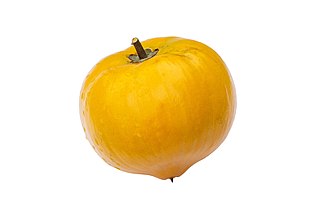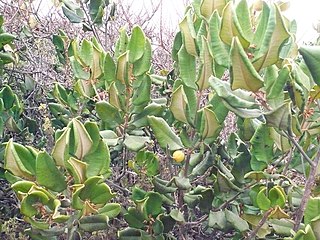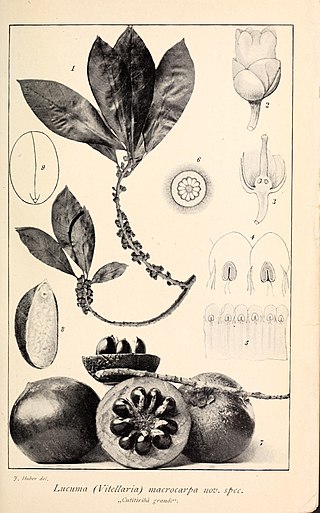
Pouteria campechiana is an evergreen tree native to, and cultivated in, southern Mexico, Belize, Guatemala, and El Salvador. It is cultivated in other countries, such as India, Costa Rica, Brazil, the United States, the Dominican Republic, Australia, Cambodia, Vietnam, Indonesia, Sri Lanka, Nigeria, and the Philippines. The edible part of the tree is its fruit, which is colloquially known as an egg fruit.

Pouteria is a genus of flowering trees in the gutta-percha family, Sapotaceae. The genus is widespread throughout the tropical Americas, with outlier species in Cameroon and Malesia. It includes the canistel, the mamey sapote, and the lucuma. Commonly, this genus is known as pouteria trees, or in some cases, eggfruits.
Corythophora labriculata is a species of woody plant in the Lecythidaceae family. It is found only in Suriname.
Micropholis resinifera is a species of plant in the family Sapotaceae. It is endemic to Brazil. It is threatened by habitat loss.
Aningeria altissima is a species of plant in the family Sapotaceae, and a source of anigre hardwood. It is found in Burundi, Cameroon, Central African Republic, the Republic of the Congo, the Democratic Republic of the Congo, Ivory Coast, Ethiopia, Gabon, Ghana, Guinea, Kenya, Nigeria, Rwanda, Sierra Leone, Sudan, Tanzania, and Uganda. It is threatened by habitat loss.
Pleioluma balansana is a species of plant in the family Sapotaceae. It is endemic to New Caledonia.
Chromolucuma congestifolia, formerly known as Pouteria congestifolia, is a species of plant in the family Sapotaceae. It is a tree native to Costa Rica and Panama.
Pouteria decussata is a species of plant in the family Sapotaceae. It is endemic to Brazil.
Pouteria fossicola is a species of plant in the family Sapotaceae. It is found in Costa Rica and Panama.
Pouteria foveolata is a species of plant in the family Sapotaceae. It is found in Costa Rica and Nicaragua.
Pouteria hotteana, the redmammee, is a species of plant in the family Sapotaceae. It is found in Haiti and Puerto Rico.
Pouteria longifolia is a species of plant in the family Sapotaceae. It is found in Bolivia and Peru.
Pouteria dominigensis is a species of plant in the family Sapotaceae. It is native to Cuba, Hispaniola, the Bahamas, and Florida. It is threatened by habitat loss.
Pouteria oppositifolia is a species of plant in the family Sapotaceae. It is endemic to Brazil. It is threatened by habitat loss.

Pouteria gardneri is a species of plant in the family Sapotaceae. It is a tree native to Brazil, Bolivia, and Paraguay. Its conservation status is insufficiently known.
Aningeria pseudoracemosa is a species of plant in the family Sapotaceae. It is endemic to Tanzania. It is known from three locations – in Kimboza Forest Reserve east of the Uluguru Mountains, and at low elevations in the East Usambara Mountains and north Udzungwa Mountains. It grows in moist lowland and foothill forests. It is endemic to the Northern Zanzibar–Inhambane coastal forest mosaic ecoregion.
Pouteria pubescens is a species of plant in the genus Pouteria within the family Sapotaceae. It is found in Brazil and Peru. Its conservation status is vulnerable. The fruit of this plant are edible and are known as eggfruits. It is a hardwood neotropical plant.

Pouteria valparadisaea, also known as Pouteria splendens, is a species of plant in the family Sapotaceae. It is endemic to the coastal areas of Central Chile. Due to the current rates of habitat loss, a recent study proposed to reclassify this species as Endangered. Produces an edible fruit similar to that of lucuma fruit.

Urera kaalae, opuhe, is a species of flowering plant in the nettle family, Urticaceae, that is endemic to the island of Oʻahu in Hawaii. It inhabits slopes and gulches in mesic forests at elevations of 300–760 m (980–2,490 ft). Currently it is restricted to the southern and central parts of the Waiʻanae Mountains. Associated plants include maile, hame, Asplenium kaulfusii, Athyrium spp., ʻāwikiwiki, pāpala, ʻakoko, poʻolā, ēlama, Doryopteris spp., ʻieʻi.e., manono, Hibiscus spp., olopua, māmaki, hala pepe, ʻālaʻa, kōpiko, heuhiuhi, aʻiaʻi, ōpuhe, and maua. It is threatened by habitat loss.

Pouteria multiflora is a plant in the family Sapotaceae of the order Ericales. Its English common name is bullytree. Its Spanish common names include jácana, ácana, acana, hacana, or jacana. It is native to North and South America. The plant is common in the Toro Negro State Forest.






